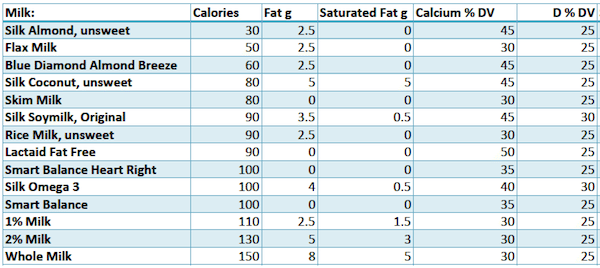Milk: Everything You Need to Know
 People have been drinking milk since about 9,000 BC, but if you take a walk through your grocery store today, you will see that milk consumption has "evolved" since then. Now consumers can choose from a range of cow’s milks, plus rice milk, soymilk, flax milk, almond milk, coconut milk, etc. Sort through your options with the milk comparison chart above, or check out the highlights below...Lowest Calorie Content: The award here goes to Silk almond milk, which has just 30 calories in a single cup. Silk recently increased the calcium content in their milk from 30% of the daily value to 45% of the daily value, which means that they can now claim that their brands of milk contain 50% more calcium than regular cow's milk.King of Sterols: It was interesting to learn that Smart Balance Heart Right contains plant sterols in addition to 20% of the daily value for Omega-3s. Plant sterols help prevent the absorption of cholesterol in the bloodstream, so they may help lower cholesterol as part of a healthful diet.Coconut Milk CAN be Lower in Fat: While Silk's coconut milk is higher in fat and saturated fat than most other milks listed in this chart, it is still much lower in fat and saturated fat than canned coconut milk. Don't be fooled by the canned versions' 1/3 cup serving size. For the sake of comparison, we calculated what each version would contain when the serving size is upped to a cup...
People have been drinking milk since about 9,000 BC, but if you take a walk through your grocery store today, you will see that milk consumption has "evolved" since then. Now consumers can choose from a range of cow’s milks, plus rice milk, soymilk, flax milk, almond milk, coconut milk, etc. Sort through your options with the milk comparison chart above, or check out the highlights below...Lowest Calorie Content: The award here goes to Silk almond milk, which has just 30 calories in a single cup. Silk recently increased the calcium content in their milk from 30% of the daily value to 45% of the daily value, which means that they can now claim that their brands of milk contain 50% more calcium than regular cow's milk.King of Sterols: It was interesting to learn that Smart Balance Heart Right contains plant sterols in addition to 20% of the daily value for Omega-3s. Plant sterols help prevent the absorption of cholesterol in the bloodstream, so they may help lower cholesterol as part of a healthful diet.Coconut Milk CAN be Lower in Fat: While Silk's coconut milk is higher in fat and saturated fat than most other milks listed in this chart, it is still much lower in fat and saturated fat than canned coconut milk. Don't be fooled by the canned versions' 1/3 cup serving size. For the sake of comparison, we calculated what each version would contain when the serving size is upped to a cup...
- Thai Kitchen Canned Regular Coconut Milk: 1 cup has 420 calories, 42 g of fat, and 36 g of saturated fat.
- Thai Kitchen Canned Light Coconut Milk: 1 cup has 150 calories, 13.5 g of fat, and 12 g of saturated fat.
- Silk Brand Coconut Milk: 1 cup has 80 calories, 5 g of fat, and 5 g of saturated fat.
Vitamin D and Calcium: The vitamin D content is about the same across the board, but many companies offer competitive claims for calcium.Cow’s Milk: Choose Skim: If you're trying to pick a cow's milk, skim milk is a good choice, with about half the calories of whole milk, none of whole milk's fat, and the same amount of calcium as whole milk.By Judy Doherty, PC II


